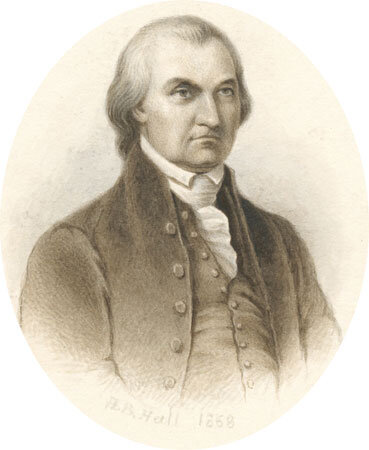
William Floyd
New York
Richard Floyd emigrated to Long Island, New York from Wales in the 17th century. His grandson, Nicoll Floyd, married Tabitha Smith and was quite successful in business and owned a large estate in Brookhaven Township, now called Mastic. On December 17, 1734, their first son was born, William.
William Floyd was provided an education that was more in the vein of practical application rather than scholarly rigor. The quality of young Floyd’s education is evidenced by the expert management of his father’s estate he exhibited when his father died. At 17 years of age, Mr. Floyd assumed control of his late father’s estate and sustained the estate’s profitability from the property’s tenants, and the produce and animals grown on the estate. Trade was also a component of his business as the property abutted the Atlantic Ocean.
Mr. Floyd’s stature and communal influence grew and he was elected a town trustee three times and served as a local militia officer. And in 1769, he became a member of the provincial assembly. He also placed a high importance on the role of Christianity in the community for he was significantly involved in serving the congregation at a local, Presbyterian church. His service in both the political and religious spheres of the community made him the ideal choice to represent the area in the Continental Congress in 1774. He, eventually, split his time between military service and public service when he was nominated colonel of the Western Regiment of Suffolk County in September 1775.
Due to the New York General Assembly’s pragmatism, William Floyd and the other New York delegates did not have the authority to vote for Richard Henry Lee’s resolution for independence on July 2, 1776. The Assembly authorized the delegates on July 9th, and on August 2nd, William Floyd added his signature to the famed document.
The cost of declaring independence from Britain came quickly as Long Island was captured by the British on August 29th. The Floyd estate was overtaken as well. Before she fled the residence, Mrs. Floyd buried the family silver. On October 17th, Mr. Floyd left Congress for a few days and strove to gather some of his possessions from his property. Needing some assistance in order to do so, Governor Jonathan Trumbull lent a hand and sent an armed group to retrieve the personal effects.
Tragedy struck the Floyd family in 1781. Due to the hardships incurred by war and being ill, Hannah Jones Floyd, Mr. Floyd’s wife, died on May 16th. Two years later, when the war ended, he returned to his estate and surveyed the ruins. Uprooted trees, burnt fences, and an unlivable house, amongst other destruction, were what his eyes beheld. In 1784, on May 16th, he married his second wife, Joanna Strong.
In time, Mr. Floyd gave his Long Island estate to his son and moved north to Oneida County. He built a house that closely resembled the Mastic estate. Several years later, during retirement, he died on August 4th, 1821.
William Floyd lived to be 86 years of age.


